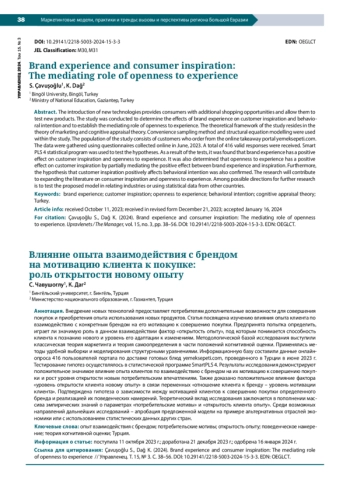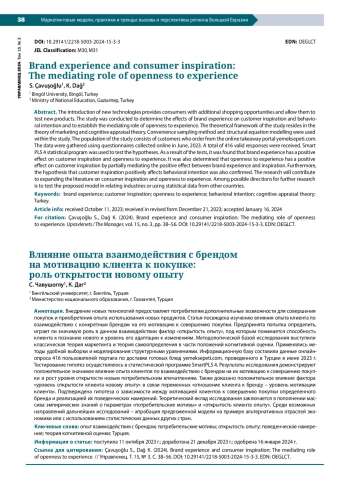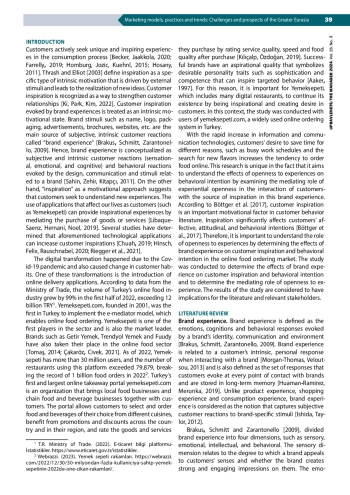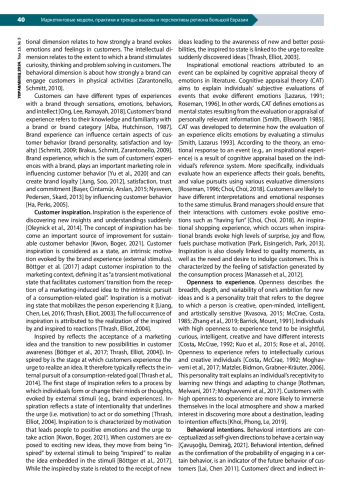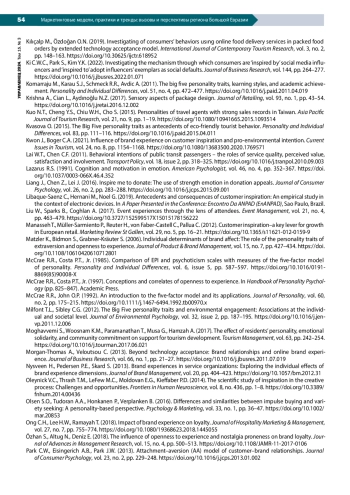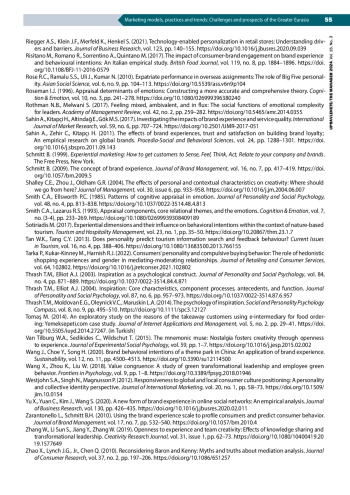The introduction of new technologies provides consumers with additional shopping opportunities and allow them to test new products. The study was conducted to determine the effects of brand experience on customer inspiration and behavioral intention and to establish the mediating role of openness to experience. The theoretical framework of the study resides in the theory of marketing and cognitive appraisal theory. Convenience sampling method and structural equation modelling were used within the study. The population of the study consists of customers who order from the online takeaway portal yemeksepeti. com. The data were gathered using questionnaires collected online in June, 2023. A total of 416 valid responses were received. Smart PLS 4 statistical program was used to test the hypotheses. As a result of the tests, it was found that brand experience has a positive effect on customer inspiration and openness to experience. It was also determined that openness to experience has a positive effect on customer inspiration by partially mediating the positive effect between brand experience and inspiration. Furthermore, the hypothesis that customer inspiration positively affects behavioral intention was also confirmed. The research will contribute to expanding the literature on consumer inspiration and openness to experience. Among possible directions for further research is to test the proposed model in relating industries or using statistical data from other countries
Идентификаторы и классификаторы
- SCI
- Социология
- УДК
- 316. Социология
Customers actively seek unique and inspiring experiences in the consumption process [Becker, Jaakkola, 2020; Farrelly, 2019; Homburg, Jozic, Kuehnl, 2015; Hosany, 2011]. Thrash and Elliot [2003] define inspiration as a specific type of intrinsic motivation that is driven by external stimuli and leads to the realization of new ideas. Customer inspiration is recognized as a way to strengthen customer relationships [Ki, Park, Kim, 2022].
Список литературы
1. Aaker J.L. (1997). Dimensions of brand personality. Journal of Marketing Research, vol. 34, no. 3, pp. 347-356. DOI: 10.2307/3151897 EDN: CORYRP
2. Alba J.W., Hutchinson J.W. (1987). Dimensions of consumer expertise. Journal of Consumer Research, vol. 13, no. 1, pp. 411-454. DOI: 10.1086/209080
3. An D., Youn N. (2018). The inspirational power of arts on creativity. Journal of Business Research, vol. 85, pp. 467-475. DOI: 10.1016/j.jbusres.2017.10.025
4. Andreini D., Pedeliento G., Zarantonello L., Solerio C. (2018). A renaissance of brand experience: Advancing the concept through a multi-perspective analysis. Journal of Business Research, vol. 91, pp. 123-133. DOI: 10.1016/j.jbusres.2018.05.046
5. Baer M., Oldham G.R. (2006). The curvilinear relation between experienced creative time pressure and creativity: Moderating effects of openness to experience and support for creativity. Journal of Applied Psychology, vol. 91, no. 4, pp. 963-970. DOI: 10.1037/0021-9010.91.4.963
6. Barrick M.R., Mount M.K. (1991). The big five personality dimensions and job performance: A meta-analysis. Personnel Psychology, vol. 44, no. 1, pp. 1-26. DOI: 10.1111/j.1744-6570.1991.tb00688.x EDN: BIREBX
7. Başer İ., Cintamür İ., Arslan F. (2015). Examining the effect of brand experience on consumer satisfaction, brand trust and brand loyalty. Marmara Üniversitesi İktisadi ve İdari Bilimler Dergisi / Marmara University Journal of Economic and Administrative Sciences, vol. 37, no. 2, pp. 101-128.
8. Becker L., Jaakkola E. (2020). Customer experience: Fundamental premises and implications for research. Journal of the Academy of Marketing Science, vol. 48, pp. 630-648. DOI: 10.1007/s11747-019-00718-x EDN: MOCRDR
9. Böttger T., Rudolph T., Evanschitzky H., Pfrang T. (2017). Customer inspiration: Conceptualization, scale development, and validation. Journal of Marketing, vol. 81, no. 6, pp. 116-131. DOI: 10.1509/jm.15.0007
10. Brakus J.J., Schmitt B.H., Zarantonello L. (2009). Brand experience: What is it? How is it measured? Does it affect loyalty? Journal of Marketing, vol. 73, no. 3, pp. 52-68. DOI: 10.1509/jmkg.73.3.52
11. Choi H., Choi H.C. (2018). Investigating tourists’ fun-eliciting process toward tourism destination sites: An application of cognitive appraisal theory. Journal of Travel Research, vol. 58, no. 5, pp. 732-744. DOI: 10.1177/0047287518776805
12. Chuah S.H.W. (2019). You inspire me and make my life better: Investigating a multiple sequential mediation model of smart-watch continuance intention. Telematics and Informatics, vol. 43, pp. 1-15. DOI: 10.1016/j.tele.2019.101245
13. Costa P.T., Jr., McCrae R.R. (1992). An introduction to the five-factor model. Journal of Personality, vol. 60, no. 2, pp. 175-215.
14. Çakaröz K.M., Civek F. (2021). Consumer ınterest to online food order sites on Google Trends: The example of Yemek Sepeti and Getir Yemek. Studies on Social Science Insights, vol. 1, no. 2, pp. 74-91. 10.53035/SOSSCI.14. (in Turkish). DOI: 10.53035/SOSSCI.14.(inTurkish)
15. Çavuşoğlu S. (2021a). The mediating role of green brand ımage and green brand loyalty in the relationship between greenwash and green purchase behavior. İşletme Araştırmaları Dergisi / Journal of Busıness Research-Turk, vol. 13, no. 3, pp. 2146-2161. DOI: 10.20491/isarder.2021.1252
16. Çavuşoğlu S. (2021b). The effect of green advertising and green brand awareness on green customer satisfaction: The mediating role of green purchasing behavior. Gaziantep University Journal of Social Sciences, vol. 20, no. 3, pp. 1355-1374. 10.21547/jss.893209. (in Turkish). DOI: 10.21547/jss.893209.(inTurkish) EDN: HCSWAC
17. Çavuşoğlu S., Bilginer F.G. (2018). Intent to vısit again the effect of the consumer experiences: The case of Bġngöl. Türk Sosyal Bilimler Araştırmaları Dergisi / Journal of Turkish Social Sciences Research, vol. 3, no. 1, pp. 72-85. (in Turkish).
18. Çavuşoğlu S., Bükey A. (2022). The effect of wellness tourism experience on tourist ınspiratıon and engagement. Journal of Gastronomy, Hospitality and Travel, vol. 5, no. 1, pp. 1-15. 10.33083/joghat.2022.108. (in Turkish). DOI: 10.33083/joghat.2022.108.(inTurkish)
19. Çavuşoğlu S., Demirağ B. (2021). The effect of consumer regret on customer satisfaction and behavioral ıntention: A research on restaurant customers. Türk Turizm Araştırmaları Dergisi / Journal of Turkish Tourism Research, vol. 5, no. 2, pp. 909-924. 10.26677/TR1010.2021.745. (in Turkish). DOI: 10.26677/TR1010.2021.745.(inTurkish)
20. Dağ K. (2022). The effects of relationship quality on word of mouth communication in the restaurant ındustry. Alanya Akademik Bakış / Alanya Academic Review Journal, vol. 6, no. 3, pp. 3349-3369. 10.29023/alanyaakademik.1062574. (in Turkish). DOI: 10.29023/alanyaakademik.1062574.(inTurkish)
21. Didier T., Lucie S. (2008). Measuring consumer’s willingness to pay for organic and fairtrade products. International Journal of Consumer Studies, vol. 32, no. 5, pp. 479-490.
22. Farrelly F. (2019). Revealing the memorial experience through the tourist-led construction of imagined communities. Tourism Management, vol. 75, pp. 13-21. DOI: 10.1016/j.tourman.2019.04.031
23. Garson G.D. (2016). Partial least squares: Regression & structural equation models. Politenessand Audience Response in Chinese-English Subtitling, Statistical Publishing Associate.
24. Graham K.A., Smith R.S. (2021). When leaders are marketers: A duality perspective on the effect of openness to experience on marketing behaviors and the moderating role of bottom-line mentality. Current Psychology, vol. 42, no. 11, pp. 9537-9551. DOI: 10.1007/s12144-021-02216-2 EDN: SXTUKU
25. Gujarati D. (1999). Basic Econometrics. İstanbul, Litaratür Yayıncılık. (in Turkish).
26. Ha H.Y., Perks H. (2005). Effects of consumer perceptions of brand experience on the web: Brand familiarity, satisfaction and brand trust. Journal of Consumer Behaviour: An International Research Review, vol. 4, no. 6, pp. 438-452. DOI: 10.1002/cb.29
27. Hair J., Jr., Sarstedt M., Hopkins L., Kuppelwieser V.G. (2014). Partial least squares structural equation modeling (PLS-SEM): An emerging tool in business research. European Business Review, vol. 26, no. 2, pp. 106-121. DOI: 10.1108/EBR-10-2013-0128
28. Han H., Hsu L.T.J., Lee J.S. (2009). Empirical investigation of the roles of attitudes toward green behaviors, overall image, gender, and age in hotel customers’ eco-friendly decision-making process. International Journal of Hospitality Management, vol. 28, no. 4, pp. 519-528. DOI: 10.1016/j.ijhm.2009.02.004
29. He M., Liu B., Li Y. (2021). Tourist ınspiration: How the wellness tourism experience ınspires tourist engagement. Journal of Hospitality & Tourism Research, vol. 47, no. 7, pp. 1115-1135. DOI: 10.1177/10963480211026376 EDN: WSSJUT
30. Hee O.C., Johari H. (2014). A conceptual analysis of personality traits and customer-oriented behaviour in the health tourism hospitals. International Journal of Caring Sciences, vol. 7, no. 2, pp. 368-374.
31. Henseler J., Ringle C.M., Sarstedt M. (2015). A new criterion for assessing discriminant validity in variance-based structural equation modeling. Journal of the Academy of Marketing Science, vol. 43, no. 1, pp. 115-135. DOI: 10.1007/s11747-014-0403-8
32. Hermann P., Nadkarni S. (2014). Managing strategic change: The duality model of CEO personality. Strategic Management Journal, vol. 35, no. 7, pp. 1318-1342.
33. Hernani-Merino M., Libaque-Saenz C.F., Dávalos J. (2023). Antecedents and consequences of customer inspiration: A framework in the context of electronic device brands. Journal of Product & Brand Management, vol. 32, no. 7, pp. 1093-1107. DOI: 10.1108/JPBM-12-2021-3799 EDN: YTDQKS
34. Hinsch C., Felix R., Rauschnabel P.A. (2020). Nostalgia beats the wow-effect: Inspiration, awe and meaningful associations in augmented reality marketing. Journal of Retailing and Consumer Services, vol. 53, 101987. DOI: 10.1016/j.jretconser.2019.101987 EDN: PKLTBI
35. Hirsh J.B. (2010). Personality and environmental concern. Journal of Environmental Psychology, vol. 30, no. 2, pp. 245-248. DOI: 10.1016/j.jenvp.2010.01.004
36. Homburg C., Jozic D., Kuehnl C. (2015). Customer experience management: Toward implementing an evolving marketing concept. Journal of the Academy of Marketing Science, vol. 45, no. 3, pp. 377-401. DOI: 10.1007/s11747-015-0460-7 EDN: SNSYQQ
37. Hosany S. (2011). Appraisal determinants of tourist emotional responses. Journal of Travel Research, vol. 51, no. 3, pp. 303-314. DOI: 10.1177/0047287511410320
38. Huaman-Ramirez R., Merunka D. (2019). Brand experience effects on brand attachment: The role of brand trust, age, and income. European Business Review, vol. 31, no. 5, pp. 610-645. DOI: 10.1108/EBR-02-2017-0039
39. Ishida C., Taylor S.A. (2012). Retailer brand experience, brand experience congruence, and consumer satisfaction. The Journal of Consumer Satisfaction, Dissatisfaction and Complaining Behavior, vol. 25, pp. 63-79.
40. Jeong E., Jang S. S., Day J., Ha S. (2014). The impact of eco-friendly practices on green image and customer attitudes: An investigation in a café setting. International Journal of Hospitality Management, vol. 41, pp. 10-20. DOI: 10.1016/j.ijhm.2014.03.002
41. Jung L.H., Soo K.M. (2012). The effect of brand experience on brand relationship quality. Academy of Marketing Studies Journal, vol. 16, no. 1, pp. 87-98.
42. Kaiser H.F. (1974). An index of factorialsimplicity. Psychometrika, vol. 39, no. 1, pp. 31-36. DOI: 10.1007/BF02291575 EDN: BEXTEB
43. Khoi N.H., Phong N.D., Le A.N.H. (2019). Customer inspiration in a tourism context: An investigation of driving and moderating factors. Current Issues in Tourism, vol. 23, no. 21, pp. 2699-2715. DOI: 10.1080/13683500.2019.1666092
44. Kılıçalp M., Özdoğan O.N. (2019). Investigating of consumers’ behaviors usıng online food delivery services in packed food orders by extended technology acceptance model. International Journal of Contemporary Tourism Research, vol. 3, no. 2, pp. 148-163. DOI: 10.30625/ijctr.618952
45. Ki C.W.C., Park S., Kim Y.K. (2022). Investigating the mechanism through which consumers are ‘inspired by’ social media influencers and ‘inspired to’ adopt influencers’ exemplars as social defaults. Journal of Business Research, vol. 144, pp. 264-277. DOI: 10.1016/j.jbusres.2022.01.071 EDN: NMWIWN
46. Komarraju M., Karau S.J., Schmeck R.R., Avdic A. (2011). The big five personality traits, learning styles, and academic achievement. Personality and Individual Differences, vol. 51, no. 4, pp. 472-477. DOI: 10.1016/j.paid.2011.04.019
47. Krishna A., Cian L., Aydınoğlu N.Z. (2017). Sensory aspects of package design. Journal of Retailing, vol. 93, no. 1, pp. 43-54. DOI: 10.1016/j.jretai.2016.12.002
48. Kuo N.T., Cheng Y.S., Chiu W.H., Cho S. (2015). Personalities of travel agents with strong sales records in Taiwan. Asia Pacific Journal of Tourism Research, vol. 21, no. 9, pp. 1-19. DOI: 10.1080/10941665.2015.1093514
49. Kvasova O. (2015). The Big Five personality traits as antecedents of eco-friendly tourist behavior. Personality and Individual Differences, vol. 83, pp. 111-116. DOI: 10.1016/j.paid.2015.04.011 EDN: WJVLFS
50. Kwon J., Boger C.A. (2021). Influence of brand experience on customer inspiration and pro-environmental intention. Current Issues in Tourism, vol. 24, no. 8, pp. 1154-1168. DOI: 10.1080/13683500.2020.1769571 EDN: QESGUJ
51. Lai W.T., Chen C.F. (2011). Behavioral intentions of public transit passengers - the roles of service quality, perceived value, satisfaction and involvement. Transport Policy, vol. 18, issue 2, pp. 318-325. DOI: 10.1016/j.tranpol.2010.09.003
52. Lazarus R.S. (1991). Cognition and motivation in emotion. American Psychologist, vol. 46, no. 4, pp. 352-367. DOI: 10.1037/0003-066X.46.4.352
53. Liang J., Chen Z., Lei J. (2016). Inspire me to donate: The use of strength emotion in donation appeals. Journal of Consumer Psychology, vol. 26, no. 2, pp. 283-288. DOI: 10.1016/j.jcps.2015.09.001
54. Libaque-Saenz C., Hernani M., Noel G. (2019). Antecedents and consequences of customer inspiration: An empirical study in the context of electronic devices. In A Paper Presented in the Conference: Encontro Da ANPAD (EnANPAD), Sao Paulo, Brazil.
55. Liu W., Sparks B., Coghlan A. (2017). Event experiences through the lens of attendees. Event Management, vol. 21, no. 4, pp. 463-479. DOI: 10.3727/152599517X15015178156222
56. Manasseh T., Müller-Sarmiento P., Reuter H., von Faber-Castell C., Pallua C. (2012). Customer inspiration-a key lever for growth in European retail. Marketing Review St Gallen, vol. 29, no. 5, pp. 16-21. DOI: 10.1365/s11621-012-0159-9
57. Matzler K., Bidmon S., Grabner-Kräuter S. (2006). Individual determinants of brand affect: The role of the personality traits of extraversion and openness to experience. Journal of Product & Brand Management, vol. 15, no. 7, pp. 427-434. DOI: 10.1108/10610420610712801
58. McCrae R.R., Costa P.T., Jr. (1985). Comparison of EPI and psychoticism scales with measures of the five-factor model of personality. Personality and Individual Differences, vol. 6, issue 5, pp. 587-597. DOI: 10.1016/0191-8869(85)90008-X
59. McCrae R.R., Costa P.T., Jr. (1997). Conceptions and correlates of openness to experience. In Handbook of Personality Psychology (pp. 825-847). Academic Press.
60. McCrae R.R., John O.P. (1992). An introduction to the five-factor model and its applications. Journal of Personality, vol. 60, no. 2, pp. 175-215. DOI: 10.1111/j.1467-6494.1992.tb00970.x
61. Milfont T.L., Sibley C.G. (2012). The Big Five personality traits and environmental engagement: Associations at the individual and societal level. Journal of Environmental Psychology, vol. 32, issue 2, pp. 187-195. DOI: 10.1016/j.jenvp.2011.12.006 EDN: YDSUKJ
62. Moghavvemi S., Woosnam K.M., Paramanathan T., Musa G., Hamzah A. (2017). The effect of residents’ personality, emotional solidarity, and community commitment on support for tourism development. Tourism Management, vol. 63, pp. 242-254. DOI: 10.1016/j.tourman.2017.06.021
63. Morgan-Thomas A., Veloutsou C. (2013). Beyond technology acceptance: Brand relationships and online brand experience. Journal of Business Research, vol. 66, no. 1, pp. 21-27. DOI: 10.1016/j.jbusres.2011.07.019
64. Nysveen H., Pedersen P.E., Skard S. (2013). Brand experiences in service organizations: Exploring the individual effects of brand experience dimensions. Journal of Brand Management, vol. 20, pp. 404-423. DOI: 10.1057/bm.2012.31
65. Oleynick V.C., Thrash T.M., LeFew M.C., Moldovan E.G., Kieffaber P.D. (2014). The scientific study of inspiration in the creative process: Challenges and opportunities. Frontiers in Human Neuroscience, vol. 8, no. 436, pp. 1-8. DOI: 10.3389/fnhum.2014.00436
66. Olsen S.O., Tudoran A.A., Honkanen P., Verplanken B. (2016). Differences and similarities between impulse buying and variety seeking: A personality-based perspective. Psychology & Marketing, vol. 33, no. 1, pp. 36-47. DOI: 10.1002/mar.20853
67. Ong C.H., Lee H.W., Ramayah T. (2018). Impact of brand experience on loyalty. Journal of Hospitality Marketing & Management, vol. 27, no. 7, pp. 755-774. DOI: 10.1080/19368623.2018.1445055
68. Özhan S., Altug N., Deniz E. (2018). The influence of openness to experience and nostalgia proneness on brand loyalty. Journal of Advances in Management Research, vol. 15, no. 4, pp. 500-513. DOI: 10.1108/JAMR-11-2017-0106
69. Park C.W., Eisingerich A.B., Park J.W. (2013). Attachment-aversion (AA) model of customer-brand relationships. Journal of Consumer Psychology, vol. 23, no. 2, pp. 229-248. DOI: 10.1016/j.jcps.2013.01.002
70. Riegger A.S., Klein J.F., Merfeld K., Henkel S. (2021). Technology-enabled personalization in retail stores: Understanding drivers and barriers. Journal of Business Research, vol. 123, pp. 140-155. DOI: 10.1016/j.jbusres.2020.09.039 EDN: BRQQBM
71. Risitano M., Romano R., Sorrentino A., Quintano M. (2017). The impact of consumer-brand engagement on brand experience and behavioural intentions: An Italian empirical study. British Food Journal, vol. 119, no. 8, pp. 1884-1896. DOI: 10.1108/BFJ-11-2016-0579
72. Rose R.C., Ramalu S.S., Uli J., Kumar N. (2010). Expatriate performance in overseas assignments: The role of Big Five personality. Asian Social Science, vol. 6, no. 9, pp. 104-113. DOI: 10.5539/ass.v6n9p104
73. Roseman I.J. (1996). Appraisal determinants of emotions: Constructing a more accurate and comprehensive theory. Cognition & Emotion, vol. 10, no. 3, pp. 241-278. DOI: 10.1080/026999396380240
74. Rothman N.B., Melwani S. (2017). Feeling mixed, ambivalent, and in flux: The social functions of emotional complexity for leaders. Academy of Management Review, vol. 42, no. 2, pp. 259-282. DOI: 10.5465/amr.2014.0355
75. Sahin A., Kitapçi H., Altindağ E., Gök M.S. (2017). Investigating the impacts of brand experience and service quality. International Journal of Market Research, vol. 59, no. 6, pp. 707-724. DOI: 10.2501/IJMR-2017-051
76. Sahin A., Zehir C., Kitapçı H. (2011). The effects of brand experiences, trust and satisfaction on building brand loyalty; An empirical research on global brands. Procedia-Social and Behavioral Sciences, vol. 24, pp. 1288-1301. DOI: 10.1016/j.sbspro.2011.09.143
77. Schmitt B. (1999). Experiential marketing: How to get customers to Sense, Feel, Think, Act, Relate to your company and brands. The Free Press, New York.
78. Schmitt B. (2009). The concept of brand experience. Journal of Brand Management, vol. 16, no. 7, pp. 417-419. DOI: 10.1057/bm.2009.5
79. Shalley C.E., Zhou J., Oldham G.R. (2004). The effects of personal and contextual characteristics on creativity: Where should we go from here? Journal of Management, vol. 30, issue 6, pp. 933-958. DOI: 10.1016/j.jm.2004.06.007 EDN: JNSUAT
80. Smith C.A., Ellsworth P.C. (1985). Patterns of cognitive appraisal in emotion. Journal of Personality and Social Psychology, vol. 48, no. 4, pp. 813-838. DOI: 10.1037/0022-3514.48.4.813
81. Smith C.A., Lazarus R.S. (1993). Appraisal components, core relational themes, and the emotions. Cognition & Emotion, vol. 7, no. (3-4), pp. 233-269. DOI: 10.1080/02699939308409189
82. Sotiriadis M. (2017). Experiential dimensions and their influence on behavioral intentions within the context of nature-based tourism. Tourism and Hospitality Management, vol. 23, no. 1, pp. 35-50. DOI: 10.20867/thm.23.1.7
83. Tan W.K., Tang C.Y. (2013). Does personality predict tourism information search and feedback behaviour? Current Issues in Tourism, vol. 16, no. 4, pp. 388-406. DOI: 10.1080/13683500.2013.766155 EDN: RNCTUD
84. Tarka P., Kukar-Kinney M., Harnish R.J. (2022). Consumers’ personality and compulsive buying behavior: The role of hedonistic shopping experiences and gender in mediating-moderating relationships. Journal of Retailing and Consumer Services, vol. 64, 102802. DOI: 10.1016/j.jretconser.2021.102802
85. Thrash T.M., Elliot A.J. (2003). Inspiration as a psychological construct. Journal of Personality and Social Psychology, vol. 84, no. 4, pp. 871-889. DOI: 10.1037/0022-3514.84.4.871 EDN: GXTQCX
86. Thrash T.M., Elliot A.J. (2004). Inspiration: Core characteristics, component processes, antecedents, and function. Journal of Personality and Social Psychology, vol. 87, no. 6, pp. 957-973. DOI: 10.1037/0022-3514.87.6.957
87. Thrash T.M., Moldovan E.G., Oleynick V.C., Maruskin L.A. (2014). The psychology of inspiration. Social and Personality Psychology Compass, vol. 8, no. 9, pp. 495-510. DOI: 10.1111/spc3.12127
88. Tomaş M. (2014). An exploratory study on the reasons of the takeaway customers using e-intermediary for food ordering: Yemeksepeti.com case study. Journal of Internet Applications and Management, vol. 5, no. 2, pp. 29-41. 10.5505/iuyd.2014.27247. (in Turkish). DOI: 10.5505/iuyd.2014.27247.(inTurkish)
89. Van Tilburg W.A., Sedikides C., Wildschut T. (2015). The mnemonic muse: Nostalgia fosters creativity through openness to experience. Journal of Experimental Social Psychology, vol. 59, pp. 1-7. DOI: 10.1016/j.jesp.2015.02.002
90. Wang J., Choe Y., Song H. (2020). Brand behavioral intentions of a theme park in China: An application of brand experience. Sustainability, vol. 12, no. 11, pp. 4500-4513. DOI: 10.3390/su12114500 EDN: UUWZWR
91. Wang X., Zhou K., Liu W. (2018). Value congruence: A study of green transformational leadership and employee green behavior. Frontiers in Psychology, vol. 9, pp. 1-8. DOI: 10.3389/fpsyg.2018.01946
92. Westjohn S.A., Singh N., Magnusson P. (2012). Responsiveness to global and local consumer culture positioning: A personality and collective identity perspective. Journal of International Marketing, vol. 20, no. 1, pp. 58-73. DOI: 10.1509/jim.10.0154
93. Yu X., Yuan C., Kim J., Wang S. (2020). A new form of brand experience in online social networks: An empirical analysis. Journal of Business Research, vol. 130, pp. 426-435. DOI: 10.1016/j.jbusres.2020.02.011 EDN: EKMBKQ
94. Zarantonello L., Schmitt B.H. (2010). Using the brand experience scale to profile consumers and predict consumer behavior. Journal of Brand Management, vol. 17, no. 7, pp. 532-540. DOI: 10.1057/bm.2010.4
95. Zhang W., Li Sun S., Jiang Y., Zhang W. (2019). Openness to experience and team creativity: Effects of knowledge sharing and transformational leadership. Creativity Research Journal, vol. 31, issue 1, pp. 62-73. DOI: 10.1080/10400419.2019.1577649 EDN: TXYYMS
96. Zhao X., Lynch J.G., Jr., Chen Q. (2010). Reconsidering Baron and Kenny: Myths and truths about mediation analysis. Journal of Consumer Research, vol. 37, no. 2, pp. 197-206. DOI: 10.1086/651257
Выпуск
Другие статьи выпуска
With the advancement of technology, many habits of people have changed. One of these is the habit of ordering food. While people used to place food orders through traditional means such as phone or email, nowadays, they can do so more quickly and easily through mobile food ordering applications (MFOAs). The increasing use of MFOAs has necessitated the exploration of factors influencing individuals’ intention to reuse these applications. The aim of this study is to investigate the factors influencing individuals’ intention to reuse MFOAs. The study is based on marketing theory and the Unified Theory of Acceptance and Use of Technology 2 (UTAUT2) model. In addition to the seven variables proposed by UTAUT2, variables related to the characteristic features of MFOAs, such as online reviews, online ratings, and online order tracking, have been added to the same model. The research data were obtained from surveys conducted with 441 MFOA users between December 2021 and March 2022. The collected data were analyzed using structural equation modeling in the R Software. As a result, it was observed that online ratings, effort expectation, online order tracking, price value, habit, and hedonic motivation variables have a significant and positive impact on the intention to reuse MFOAs. Social influence, facilitating conditions, performance expectation, and online reviews were found to have no effect on customers’ reuse intentions toward MFOAs. The findings of the study provide insights into understanding consumer preferences and purchase intentions, offering a prediction for MFOA service providers competing for a larger market share.
Проблематика «зеленого» маркетинга и его влияния на потребительское поведение, а также вопросы эволюции собственных торговых марок (СТМ) розничных сетей достаточно хорошо освещены, но до сих пор нет комплексных исследований, посвященных взаимосвязи этих трех аспектов. Статья направлена на изучение факторов, влияющих на решение потребителей о приобретении «зеленых» СТМ, и определение характеристик товаров, которые российские потребители воспринимают как «зеленые», то есть безопасные для самого потребителя и окружающей среды на всех стадиях производственного, реализационного и утилизационного циклов. Методология работы опирается на теории маркетинга отношений, потребительского выбора, восприятия ценности (value perception theory) и концепцию устойчивого развития. Информационной базой для эмпирического исследования послужили глубинные экспертные интервью с представителями розничных сетей и результаты анкетирования 373 респондентов. Полученные данные обработаны с помощью методов корреляционного и регрессионного анализа, контент-анализа. Результаты исследования показали, что цена СТМ не является единственным фактором потребительского выбора: на него влияют как социально-демографические характеристики респондентов, так и различные дополнительные свойства СТМ, в числе которых – набор «зеленых» характеристик, информативность упаковки, социальная ориентация СТМ и др. Полученные выводы могут быть востребованы в планировании маркетинговых кампаний по продвижению собственных торговых марок сетей
На российском рынке маргариновой продукции наблюдаются изменения моделей потребительского поведения, отрасль столкнулась с падением продаж ряда брендов. Исследование направлено на выявление новых трендов на рынке масложировой продукции и проверку гипотез о сокращении потребления маргарина конечными потребителями по причине популярности здорового образа жизни, быстро растущего спроса на готовую еду и выпечку, высокой чувствительности покупателей к цене. Методологическую основу исследования составили теории бренд-менеджмента и маркетинга. Использованы методы кабинетного и полевого маркетинговых исследований, опрос, статистические методы анализа. Расчеты проведены с помощью статистического программного обеспечения SPSS и JASP. Для оценки брендменеджмента компаний применялись индекс лояльности бренду, показатель знания брендов в Яндекс Wordstat. Информационную базу работы составили панельные данные Nielsen по ритейл-аудиту на рынках товаров повседневного спроса за 2021–2023 гг., аналитической платформы QlickView, отчет ООО «Профи Исследования» по итогам полевого исследования брендов маргарина в ноябре 2023 г., материалы опроса, проведенного авторами в ноябре – декабре 2023 г. Получен вывод о сокращении доли маргарина в общем объеме производства и продаж твердых жиров. Подтвердились гипотезы об уменьшении покупок маргаринов из-за стремления к здоровому образу жизни и по рекомендации врача. Выявлено, что цена является ключевым фактором при выборе маргариновой продукции.
С учетом адаптивности покупателей к устоявшимся маркетинговым стимулам возникает необходимость совершенствования способов продвижения текстильной продукции. Применение нейротехнологий позволяет определить потенциальные «якоря» в виде этнических орнаментов для сувенирной продукции. Исследование направлено на выявление нейромаркетинговых метрик потребительского восприятия этнических орнаментов для сувенирной одежды на основе искусственного интеллекта. Методологической базой работы послужили положения сенсорного маркетинга. Использовались общие маркетинговые и специальные нейромаркетинговые методы исследования. Информационную базу составил массив данных, полученных в рамках электроэнцефалографических экспериментов и фокус-группы, в которых участвовало 12 чел., и выборочного предварительного опроса, охватывающего 90 чел. Исследования были проведены в период с января по февраль 2024 г. Разработаны подходы к нейромаркетинговой потребительской оценке этнических орнаментов для сувенирной одежды, основанные на биометрических данных. Выявлены реакции потребителей на разные виды этнических орнаментов одежды. На базе электроэнцефалографического обследования и вербального опроса экспериментальной группы были выбраны наиболее сильные эмоциональные реакции на отдельные виды орнаментов. Полученные результаты были обработаны с помощью искусственного интеллекта для создания современного дизайна сувенирной продукции, в котором использованы этнические национальные узоры. Результаты исследования вносят вклад в понимание влияния ароматической нейростимуляции на восприятие элементов одежды, а также возможностей искусственного интеллекта в формировании обоснованных маркетинговых решений
Тенденция старения населения обусловливает необходимость анализа поведения так называемых серебряных потребителей. Одной из ключевых особенностей этого поведения является низкая готовность к совершению онлайн-покупок. Статья посвящена оценке роли индивидуальных характеристик, воспринимаемых выгод и рисков в онлайн-покупках лиц старшего возраста. Методологическую базу исследования составила концепция воспринимаемых выгод и рисков. В качестве методов использовались качественные интервью, количественный опрос, факторный анализ и моделирование структурными уравнениями. Информационной базой исследования послужили материалы 10 интервью и 244 анкет потребителей в возрасте 50 лет и старше. По результатам анализа впервые выявлены значимые предикторы интернет-покупок российских потребителей старшей возрастной группы. Так, риск оценки, производственный и финансовый риски снижают вероятность покупок онлайн, а разнообразие ассортимента повышает намерение совершать такие покупки в будущем. При этом наличие опыта покупок в интернете снижает восприятие рисков и повышает восприятие выгод. Значимую роль играют и навыки пользования интернетом: чем они лучше, тем выше вероятность онлайн-покупок. Также выявлено положительное влияние разницы биологического и когнитивного возраста: чем моложе ощущает себя индивид, тем выше вероятность совершения покупок в интернете. Полученные результаты позволяют онлайн-ритейлерам скорректировать практики работы с потребителями старшего поколения.
Переход рынка торговых центров в стадию зрелости трансформирует поведение покупателей и требует пересмотра подходов к их сегментации. Статья посвящена объяснению покупательского поведения россиян при совершении покупок в торговых центрах, их отношения к ценности шопинга и атрибутам торгового центра с учетом поколенческой и гендерной разницы для обоснования подхода к сегментации покупателей на стадии зрелости рынка. Методология исследования строится на теориях поколений и потребительской ценности. В качестве методов обработки данных использовались частотный, факторный, регрессионный, дисперсионный и кластерный анализ. Информационная база включает данные онлайн-опроса 531 респондента, проведенного в декабре 2023 г. – январе 2024 г. Результаты исследования показывают, что принадлежность покупателей к поколенческой когорте оказывает статистически значимое влияние на их поведение и отношение к атрибутам торгового центра. Гендерная разница лишь частично объясняет поведение потребителей при покупках. Поколенческие и гендерные различия выявлены в отношении гедонистической ценности шопинга: статистически значима реакция молодых покупателей и покупателей-женщин. Уровень дохода не определяет разницу в поведении потребителей. Кластерный анализ доказал, что основой сегментации покупателей являются психографические переменные – отношение к ценности шопинга и важность атрибутов торгового центра. Демографические факторы сегментации демонстрируют общую вторичность в условиях перехода рынка торговых центров в стадию зрелости. На первый план выходят психографические факторы: утилитарная и гедонистическая ценности шопинга, важность гигиенических и опытных атрибутов торговых центров
Статистика статьи
Статистика просмотров за 2025 год.
Издательство
- Издательство
- УрГЭУ
- Регион
- Россия, Екатеринбург
- Почтовый адрес
- 620144, Уральский ФО, Свердловская область, г. Екатеринбург, ул. 8 Марта/Народной Воли, д. 62/45
- Юр. адрес
- 620144, Уральский ФО, Свердловская область, г. Екатеринбург, ул. 8 Марта/Народной Воли, д. 62/45
- ФИО
- Силин Яков Петрович (РЕКТОР)
- E-mail адрес
- odo@usue.ru
- Сайт
- https://www.usue.ru/
